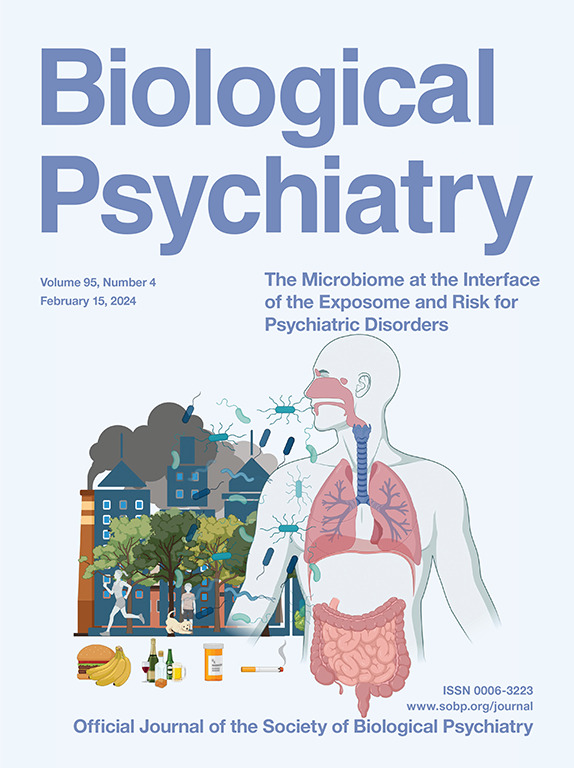找到合适的剂量:针对精神分裂症认知和可塑性缺陷的 NMDAR 调节疗法以及药效学目标参与的作用。
IF 9.6
1区 医学
Q1 NEUROSCIENCES
引用次数: 0
摘要
与精神分裂症相关的认知障碍(CIAS)和相关的学习(可塑性)缺陷是精神分裂症致残的主要原因之一。尽管如此,美国食品及药物管理局(FDA)仍未批准针对 CIAS 的治疗方法,而在小规模研究中显示出初步前景的化合物在 II/III 期研究中的多次失败也限制了治疗方法的开发。N-甲基-d-天冬氨酸型谷氨酸受体(NMDAR)被认为在精神分裂症中发挥着重要作用;此外,NMDAR在认知、学习和神经可塑性方面的作用也得到了很好的体现。我们回顾了已发表的关于 NMDAR 调节剂治疗 CIAS 的临床试验,重点关注已发表的和最近的研究进展,即单独使用新型 NMDAR 调节剂治疗 CIAS,以及将其与可塑性/学习范式相结合以提高学习能力。我们将通过对先前研究的讨论,强调在治疗开发早期纳入药效学目标参与生物标志物的重要性,这有助于预测哪些化合物将在第三阶段取得成功或失败。研究将涉及一系列直接和间接的 NMDAR 调节剂,包括 d-丝氨酸、d-环丝氨酸、美金刚、甘氨酸和 "第一代 "甘氨酸转运抑制剂 (GTI,如肌氨酸和比托泊汀),以及最近对新型 GTI iclepertin 和可提高大脑 d-丝氨酸水平的 D-氨基酸氧化酶抑制剂 (DAAO-I) luvadaxistat 的积极研究和间接非侵入性脑刺激 NMDAR 调节疗法。将重点介绍成功使用药效学目标参与生物标记物进行剂量/药物发现的几个实例,包括错配负性(MMN)、听觉稳态(ASSR)和时频事件相关电位(TF-ERP)方法。本文章由计算机程序翻译,如有差异,请以英文原文为准。
Finding the Right Dose: NMDA Receptor–Modulating Treatments for Cognitive and Plasticity Deficits in Schizophrenia and the Role of Pharmacodynamic Target Engagement
Cognitive impairment associated with schizophrenia (CIAS) and related deficits in learning (plasticity) are among the leading causes of disability in schizophrenia. Despite this, there are no Food and Drug Administration–approved treatments for CIAS, and the development of treatments has been limited by numerous phase 2/3 failures of compounds that showed initial promise in small-scale studies. NMDA-type glutamate receptors (NMDARs) have been proposed to play an important role in schizophrenia; moreover, the NMDAR has a well-characterized role in cognition, learning, and neuroplasticity. We review previously published clinical trials in CIAS that focused on NMDAR modulator treatments, focusing on published and recent developments of the use of novel NMDAR-modulating treatments for CIAS both alone and combined with plasticity/learning paradigms to enhance learning. We use this discussion of previous studies to highlight the importance of incorporating pharmacodynamic target engagement biomarkers early in treatment development, which can help predict which compounds will succeed or fail in phase 3. A range of direct and indirect NMDAR modulators are covered, including D-serine, D-cycloserine, memantine, and glycine and first-generation glycine transport inhibitors (e.g., sarcosine and bitopertin), as well as recent positive studies of iclepertin, a novel glycine transport inhibitor, and luvadaxistat, a D-amino acid oxidase inhibitor that increases brain D-serine levels, and indirect noninvasive brain stimulation NMDAR-modulating treatments. Several examples of successful use of pharmacodynamic target engagement biomarkers for dose/drug discovery are emphasized, including the mismatch negativity, auditory steady state, and time-frequency event-related potential approaches.
求助全文
通过发布文献求助,成功后即可免费获取论文全文。
去求助
来源期刊

Biological Psychiatry
医学-精神病学
CiteScore
18.80
自引率
2.80%
发文量
1398
审稿时长
33 days
期刊介绍:
Biological Psychiatry is an official journal of the Society of Biological Psychiatry and was established in 1969. It is the first journal in the Biological Psychiatry family, which also includes Biological Psychiatry: Cognitive Neuroscience and Neuroimaging and Biological Psychiatry: Global Open Science. The Society's main goal is to promote excellence in scientific research and education in the fields related to the nature, causes, mechanisms, and treatments of disorders pertaining to thought, emotion, and behavior. To fulfill this mission, Biological Psychiatry publishes peer-reviewed, rapid-publication articles that present new findings from original basic, translational, and clinical mechanistic research, ultimately advancing our understanding of psychiatric disorders and their treatment. The journal also encourages the submission of reviews and commentaries on current research and topics of interest.
 求助内容:
求助内容: 应助结果提醒方式:
应助结果提醒方式:


